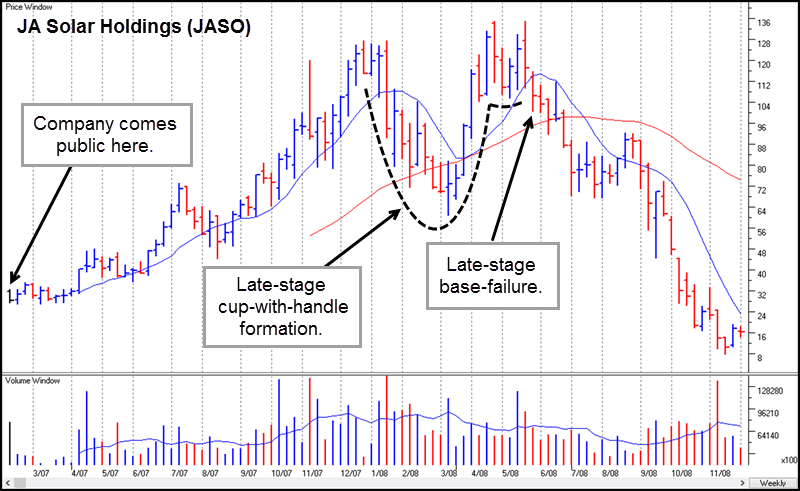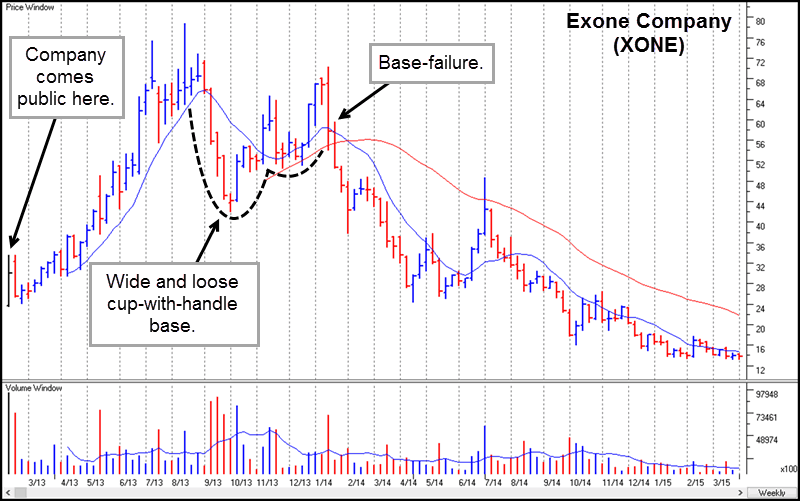The Life-Cycles of Stocks Part 3: IPO Flame-Outs

With this, the third and final installment of articles discussing the “life-cycles” of stocks, we delve into the phenomenon of “IPO Flame-Outs.” These stocks might be considered the James Deans, Jimi Hendrixes, and River Phoenixes of the equity markets; brightly shining, rapidly rising young stars that live “life in the fast lane” and die early deaths, sometimes ignominiously so.
Unlike those stocks that have long or multiple life-cycles, these stocks are characterized by a very short, often mercurial life-span that begins shortly after the stock goes public in an initial public offering, or IPO. Most of the time, these stocks are IPOs in an industry group that has become a hot area of interest for investors, and their price performance is associated with a crescendo of speculative fever that ignites huge, sometimes even parabolic, upside price moves. But like a Fourth of July bottle rocket, their steep ascents often end in a big blow-up or “flame out” at the top that results in an equally rapid downside price disintegration. In the process, these IPO Flame-Outs can also make for very profitable short-sale candidates, once the speculative buying fever in the stock is finally snuffed out, and the stock experiences an equally rapid downside disintegration.
Many investors can remember when the solar energy stocks became a hot commodity during the 2007 bull market, and investors couldn’t get enough of them. Big names in the group like Sunpower (SPWR) and First Solar (FSLR) had already come public in late 2005 and late 2006, respectively, and were in the midst of what would become big, upside price moves over the next year by the time JA Solar Holdings (JASO) was coming public in late February 2007. As we can see on the weekly timeframe in Chart 1, below, JASO moved sideways for eight weeks after its IPO before breaking out and initiating a strong upside trend from there. We can consider this first breakout from the post-IPO consolidation or “base” to be the “first-stage” breakout.

Chart 1 – JA Solar Holdings (JASO) weekly chart 2007-2008. Chart courtesy of HGS Investor Software, LLC, ©2015, used by permission.
From there, JASO formed three more consolidations or bases on the way up before finally forming a late-stage cup-with-handle formation, outlined on the chart above. In this case, the late-stage cup was extremely deep, -52.3% to be precise, with wide weekly price ranges that give it a loose, sloppy look. Thus this pattern was failure-prone, and when the stock tried to break out to new highs in late May 2008, it failed and began to break down in earnest. This is what is known as a “late-stage base-failure,” and it is generally a classic topping formation that prowling short-sellers should be alert to. A few months later, the other solars like FSLR and SPWR began to come apart, and this coincided with JASO’s acceleration to the downside in late August 2008 just as the infamous financial crisis of 2008 was coming to full fruition.
The basic elements of the “IPO Flame-Out” are also seen in the short life-cycle of three-dimensional printing concern Exone Company (XONE), which went public in the midst of the speculative fever and fervor surrounding the three-dimensional printing craze of 2012-2013. At the time, three-dimensional printing was considered a highly “disruptive” technology, and this fed investors’ insatiable appetite for the stocks of companies in the 3-D printing industry. XONE catered to this appetite by going public in late February 2013, long after the bigger, more established names in the 3-D printing group, Three-D Systems (DDD) and Stratasys (SSYS) were firmly entrenched in strong uptrends that had commenced in early 2012.
After going public, XONE formed a cup-with-handle type of base and broke out at around 34-35 a share in early April 2013, streaking to the upside before reaching a high of 78.80 in 18 weeks, as we can see on the weekly timeframe in the chart below. This was more than a double from the breakout point and a 235% increase from its IPO offering price of $18.

Chart 2 – Exone Company (XONE) weekly chart 2013-2015. Chart courtesy of HGS Investor Software, LLC, ©2015, used by permission.
The mania surrounding the 3-D printing stock phenomena, like all manias, came to an end for Exone Company (XONE) in early March of 2015 when it failed on a breakout attempt from an improper cup-with-handle that was -46.7% deep. Like JASO, XONE’s topping formation consisted of a deep, cup-with-handle formation that was wide, loose, and failure-prone as outlined in Chart 2. We can see that this failed base breakout in early January 2014 led to a sharp price descent that eventually took the stock well below its January 2013 IPO offering price of $18 a share.
In both JASO and XONE, we see the phenomenon of a hot IPO showing up in the midst of a speculative mania surrounding its industry. This industry-related mania, whether centered on solar stocks or 3-D printing stocks, is manifested by other strong, leading stocks in the group that is already having strong price moves based on the intense investor interest in that group’s industry.
In JASO’s case, prior leading solar names like FSLR and SPWR were already on a tear by the time it came into existence as a publicly-traded company in early 2008. In XONE’s case, its IPO in January 2013 came about in the midst of strong upside price moves that were already in progress in more-established 3-D printing names like DDD and SSYS. But they still arrived on their respective scenes early enough to catch a scintillating ride on the big group-related wave. However, once the speculative fever surrounding the industry of each fizzled out, the stocks, as highly speculative late-comers to their respective industry manias, flamed out in brutal fashion.
For investors who like to play these types of situations on either or both the long and short side by capitalizing on their rapid upside and downside movement, it is useful to maintain an acute awareness of stocks that may be developing in similar fashion in the current market environment. Hot concepts, themes, and outright manias occur often enough in the stock market. For those who are able to recognize what they are seeing in real-time and who understand how such situations can play out, they make for some of the best profit opportunities available to active investors.
#####
For more on Gil Morales, and to get the Gilmo Report, please click here.
*****
Related Reading …
The Life-Cycles of Stocks Part 1: Tesla Motors
The Life-Cycles of Stocks Part 2: Apple (AAPL)


